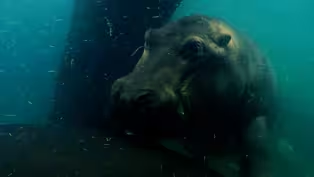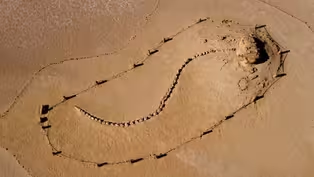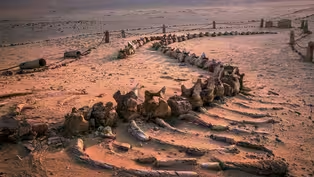
Ancient whale fossils found in the desert
Clip: Season 51 Episode 1 | 2m 10sVideo has Closed Captions
What is this whale skeleton doing in the Egyptian Sahara Desert?
This part of the Sahara Desert is the resting place of some of the earliest whales ever found. These fossils may hold the key to how whales evolved.
Problems playing video? | Closed Captioning Feedback
Problems playing video? | Closed Captioning Feedback
National Corporate funding for NOVA is provided by Carlisle Companies and Viking Cruises. Major funding for NOVA is provided by the NOVA Science Trust, the Corporation for Public Broadcasting, and PBS viewers.

Ancient whale fossils found in the desert
Clip: Season 51 Episode 1 | 2m 10sVideo has Closed Captions
This part of the Sahara Desert is the resting place of some of the earliest whales ever found. These fossils may hold the key to how whales evolved.
Problems playing video? | Closed Captioning Feedback
How to Watch NOVA
NOVA is available to stream on pbs.org and the free PBS App, available on iPhone, Apple TV, Android TV, Android smartphones, Amazon Fire TV, Amazon Fire Tablet, Roku, Samsung Smart TV, and Vizio.
Buy Now

NOVA Labs
NOVA Labs is a free digital platform that engages teens and lifelong learners in games and interactives that foster authentic scientific exploration. Participants take part in real-world investigations by visualizing, analyzing, and playing with the same data that scientists use.Providing Support for PBS.org
Learn Moreabout PBS online sponsorship(mysterious music) - [Narrator] Across more than 75 square miles, fossils litter the desert.
There are so many Hisham has to remove his shoes to avoid crushing them.
- This is typically what you see in Wadi Hitan.
The bone is sticking out from the cliff, calling you to come and see it.
You can find ribs all over the place.
Giving the size of the vertebrae, it might be getting up to 20 meter long.
- [Narrator] The size and shape of an animal around 60 feet long encased in this rock has led scientists to a remarkable conclusion.
- I think we have a complete skeleton of the prehistoric whale that lived here in Egypt long, long, long time ago.
(calm music) - [Narrator] This is the biggest ancient whale graveyard known on Earth.
That's why paleontologists named it Wadi Hitan, the Valley of the Whales.
But what are these sea creatures doing here in a desert over a hundred miles from the coast?
It's clear this area was once underwater.
(intriguing music) Today's excavation site was at the bottom of the sea 40 million years ago.
Back then, the Mediterranean was part of a much larger ocean, the Tethys.
It stretched from Europe to India and was full of marine life.
But when sea levels dropped, they left behind a seabed rich in fossils.
Today, this desert is the resting place of some of the earliest whales ever found.
They may hold the key to how today's ocean giants evolved.
How Did Whales Evolve From Land Mammals?
Video has Closed Captions
Clip: S51 Ep1 | 3m 8s | The story of whales’ evolution from land mammals is hidden in their genes. (3m 8s)
This Massive Skeleton Belongs to an Ancient Whale
Video has Closed Captions
Clip: S51 Ep1 | 2m 28s | At first, scientists thought it was a gigantic marine reptile. (2m 28s)
Video has Closed Captions
Clip: S51 Ep1 | 2m 48s | Today’s whales look nothing like their ancient ancestor. (2m 48s)
When Whales Could Walk Preview
Video has Closed Captions
Preview: S51 Ep1 | 30s | Giant fossils uncovered in the Sahara Desert reveal new secrets of how whales evolved. (30s)
Providing Support for PBS.org
Learn Moreabout PBS online sponsorship
- Science and Nature

Capturing the splendor of the natural world, from the African plains to the Antarctic ice.

- Science and Nature

Learn how centuries of knowledge helped our ancestors understand the mysteries of space.












Support for PBS provided by:
National Corporate funding for NOVA is provided by Carlisle Companies and Viking Cruises. Major funding for NOVA is provided by the NOVA Science Trust, the Corporation for Public Broadcasting, and PBS viewers.





